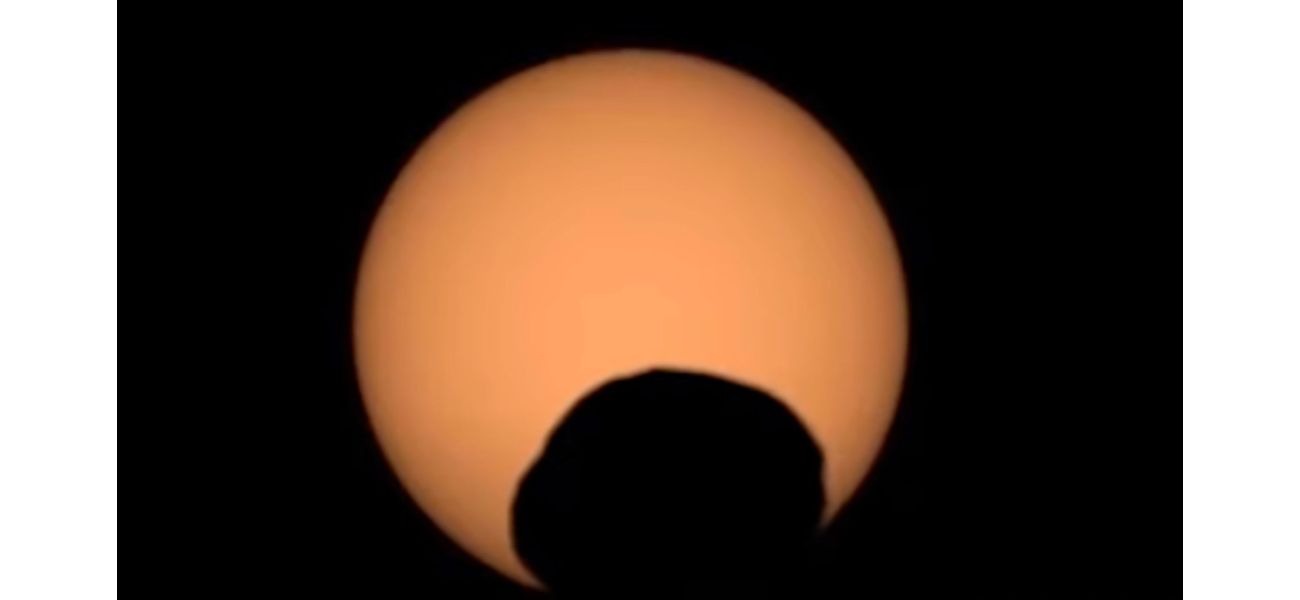Perseverance rover on Mars captured an unusual 'googly eye' image.
Phobos, one of Mars' moons, created a unique shadow on both the sun and the planet's surface as it passed in front of the sun.
October 31st 2024.

During a recent solar eclipse, the Perseverance rover on Mars was able to capture a unique and intriguing sight - a cosmic "googly eye." As one of Mars' two moons, Phobos, passed in front of the sun, it cast a shadow on the sun's face and the Martian surface, resembling a lumpy, potato-shaped eye. The rover, currently exploring the western wall of Jezero Crater, recorded a video of the partial eclipse on September 30, giving us a closer look at this fascinating celestial event.
Compared to the minutes-long eclipses seen from Earth, the one on Mars was relatively brief, lasting only about 30 seconds. This is because Phobos is much smaller in diameter than Earth's moon, about 157 times smaller, according to NASA. This eclipse is just the latest in a series of Martian eclipses captured by rovers, including a video recorded by Curiosity in 2019 and a photo taken by Opportunity in 2004.
Each time a robotic explorer captures a video or photo of a Martian eclipse, astronomers are able to learn more about the changing orbit of Phobos and its eventual fate. Sadly, Phobos is doomed from the start. It completes an orbit around the Martian equator every 7.6 hours, or three times a day, and is about 6000 kilometers from the surface of the red planet. Pockmarked by meteorites, it was once nearly shattered by a giant impact. While it managed to survive, Phobos is slowly drawing closer to Mars and will either collide with the planet in 50 million years or break up and form a ring around it.
The discovery of Mars' two moons, Phobos and Deimos, dates back to 1877 when astronomer Asaph Hall named them after the Greek gods associated with fear and panic. However, their origins remain a mystery, with some scientists speculating that they may be captured asteroids or fragments from a giant impact with Mars. To shed light on these enduring riddles, the Japan Aerospace Exploration Agency is planning a mission called Martian Moons eXploration (MMX), which will closely observe both moons and even collect a sample from Phobos to bring back to Earth.
While MMX is still in the works, the Perseverance rover continues to push forward with its mission. Currently, it is making its way up the slippery, 20-degree-sloped surface of the crater wall, using innovative methods such as driving backward and switchbacking to navigate the challenging terrain. The rover's engineering team has also found that following the northern edge of the "Summerland Trail" has been the most efficient route, possibly due to the presence of large rocks that provide better traction.
But the team is determined to reach their destination and is anticipating that the rover will reach the crater rim by December. Recently, Perseverance shared a mosaic of 44 images, showcasing landmark moments from its journey on the red planet. This includes its landing site and the final airfield of the Ingenuity helicopter, giving us a glimpse into its three-and-a-half-year journey.
Once Perseverance reaches the crater rim, it will continue its journey towards Witch Hazel Hill, a light-colored bedrock area that has been identified as a potential location for drilling a rock sample. The rover's science team is hopeful that these samples could provide evidence of past microbial life on Mars, when the planet had flowing water and a river delta in Jezero Crater. So far, the journey has not been easy, but Perseverance is determined to overcome any challenges in its quest for knowledge on the red planet.
Compared to the minutes-long eclipses seen from Earth, the one on Mars was relatively brief, lasting only about 30 seconds. This is because Phobos is much smaller in diameter than Earth's moon, about 157 times smaller, according to NASA. This eclipse is just the latest in a series of Martian eclipses captured by rovers, including a video recorded by Curiosity in 2019 and a photo taken by Opportunity in 2004.
Each time a robotic explorer captures a video or photo of a Martian eclipse, astronomers are able to learn more about the changing orbit of Phobos and its eventual fate. Sadly, Phobos is doomed from the start. It completes an orbit around the Martian equator every 7.6 hours, or three times a day, and is about 6000 kilometers from the surface of the red planet. Pockmarked by meteorites, it was once nearly shattered by a giant impact. While it managed to survive, Phobos is slowly drawing closer to Mars and will either collide with the planet in 50 million years or break up and form a ring around it.
The discovery of Mars' two moons, Phobos and Deimos, dates back to 1877 when astronomer Asaph Hall named them after the Greek gods associated with fear and panic. However, their origins remain a mystery, with some scientists speculating that they may be captured asteroids or fragments from a giant impact with Mars. To shed light on these enduring riddles, the Japan Aerospace Exploration Agency is planning a mission called Martian Moons eXploration (MMX), which will closely observe both moons and even collect a sample from Phobos to bring back to Earth.
While MMX is still in the works, the Perseverance rover continues to push forward with its mission. Currently, it is making its way up the slippery, 20-degree-sloped surface of the crater wall, using innovative methods such as driving backward and switchbacking to navigate the challenging terrain. The rover's engineering team has also found that following the northern edge of the "Summerland Trail" has been the most efficient route, possibly due to the presence of large rocks that provide better traction.
But the team is determined to reach their destination and is anticipating that the rover will reach the crater rim by December. Recently, Perseverance shared a mosaic of 44 images, showcasing landmark moments from its journey on the red planet. This includes its landing site and the final airfield of the Ingenuity helicopter, giving us a glimpse into its three-and-a-half-year journey.
Once Perseverance reaches the crater rim, it will continue its journey towards Witch Hazel Hill, a light-colored bedrock area that has been identified as a potential location for drilling a rock sample. The rover's science team is hopeful that these samples could provide evidence of past microbial life on Mars, when the planet had flowing water and a river delta in Jezero Crater. So far, the journey has not been easy, but Perseverance is determined to overcome any challenges in its quest for knowledge on the red planet.
[This article has been trending online recently and has been generated with AI. Your feed is customized.]
[Generative AI is experimental.]
0
0
Submit Comment





